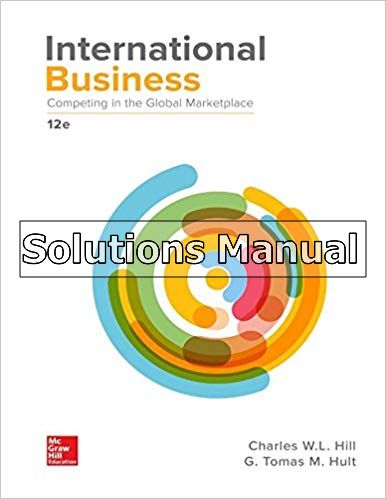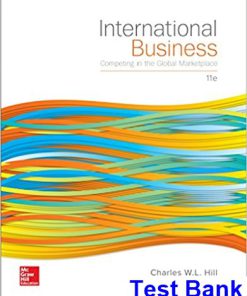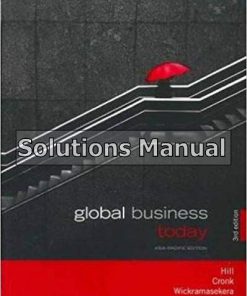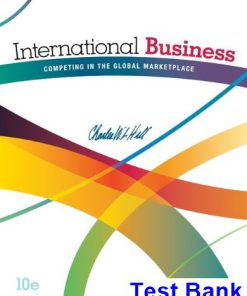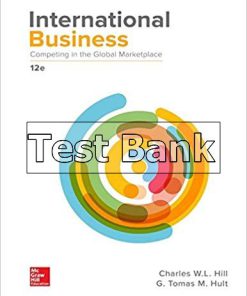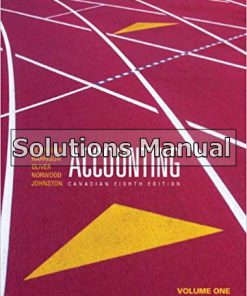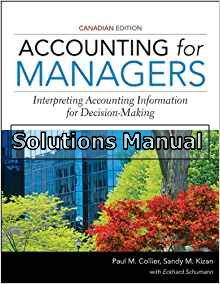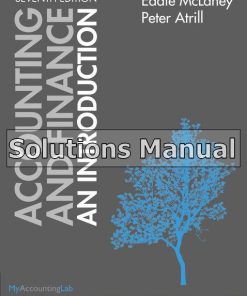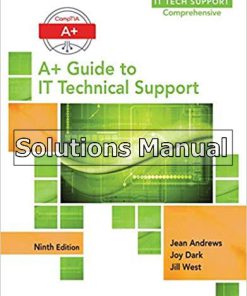International Business Competing in the Global Marketplace 12th Edition Hill Solutions Manual
$26.50$50.00 (-47%)
International Business Competing in the Global Marketplace 12th Edition Hill Solutions Manual.
You may also like
International Business Competing in the Global Marketplace 12th Edition Hill Solutions Manual
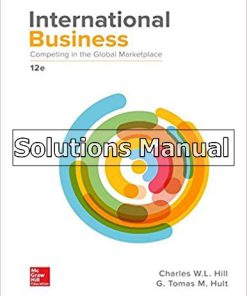
Product Details:
- ISBN-10 : 1259929442
- ISBN-13 : 978-1259929441
- Author:
Market-defining since it was introduced, International Business: Competing in the Global Marketplace by Charles W.L. Hill (University of Washington) and G. Tomas Hult (Michigan State University) sets the standard, and is the proven choice for International Business. With the 12th edition, Hill and Hult continue to draw upon their experience to deliver a complete program that is: Relevant – Timely, Comprehensive Coverage or Theory; Practical – Focused on Practical Applications of Concepts; Integrated – Integrated Progression of Topics with Results-Driven Technology.
Table of Content:
- Chapter 1 Globalization
- Opening Case Globalization of BMW, Rolls-Royce, and the MINI
- Introduction
- What Is Globalization?
- Management Focus
- Boeing’s Global Production System
- The Emergence of Global Institutions
- Drivers of Globalization
- The Changing Demographics of the Global Economy
- Country Focus
- India’s Software Sector
- Management Focus
- Wanda Group
- The Globalization Debate
- Country Focus
- Protesting Globalization in France
- Managing in the Global Marketplace
- Chapter Summary
- Critical Thinking and Discussion Questions
- Research Task
- Closing Case
- Uber: Going Global from Day One
- Endnotes
- part two National Differences
- Chapter 2 National Differences in Political, Economic, and Legal Systems
- Opening Case
- The Decline of Zimbabwe
- Introduction
- Political Systems
- Country Focus
- Putin’s Russia
- Economic Systems
- Legal Systems
- Country Focus
- Corruption in Brazil
- Management Focus
- Did Walmart Violate the Foreign Corrupt Practices Act?
- Management Focus
- Starbucks Wins Key Trademark Case in China
- Focus on Managerial Implications: The Macro Environment Influences Market Attractiveness
- Chapter Summary
- Critical Thinking and Discussion Questions
- Research Task
- Closing Case
- Economic Transformation in Vietnam
- Endnotes
- Chapter 3 National Differences in Economic Development
- Opening Case
- Economic Development in Bangladesh
- Introduction
- Differences in Economic Development
- Map 3.1 GNI per capita, 2016
- Map 3.2 GNI PPP per capita, 2016
- Map 3.3 Average annual growth rate in GDP (%), 2007–2016
- Map 3.4 Human Development Index, 2015
- Political Economy and Economic Progress
- Country Focus
- Emerging Property Rights in China
- States in Transition
- Map 3.5 Freedom in the world, 2017
- Map 3.6 Index of economic freedom, 2017
- The Nature of Economic Transformation
- Country Focus
- India’s Economic Transformation
- Implications of Changing Political Economy
- Focus on Managerial Implications: Benefits, Costs, Risks, and Overall Attractiveness of Doing Business Internationally
- Chapter Summary
- Critical Thinking and Discussion Questions
- Research Task
- Closing Case
- The Political and Economic Evolution of Indonesia
- Endnotes
- Chapter 4 Differences in Culture
- Opening Case
- The Swatch Group and Cultural Uniqueness
- Introduction
- What Is Culture?
- Social Structure
- Country Focus
- India and Its Caste System
- Religious and Ethical Systems
- Map 4.1 World Religions
- Country Focus
- Secularism in Turkey
- Management Focus
- China and Its Guanxi
- Language
- Education
- Culture and Business
- Cultural Change
- Focus on Managerial Implications: Cultural Literacy and Competitive Advantage
- Chapter Summary
- Critical Thinking and Discussion Questions
- Research Task
- Closing Case
- The Emirates Group and Employee Diversity
- Endnotes
- Chapter 5 Ethics, Corporate Social Responsibility, and Sustainability
- Opening Case
- Woolworths Group’s Corporate Responsibility Strategy 2020
- Introduction
- Ethics and International Business
- Management Focus
- “Emissionsgate” at Volkswagen
- Ethical Dilemmas
- Roots of Unethical Behavior
- Philosophical Approaches to Ethics
- Focus on Managerial Implications: Making Ethical Decisions Internationally
- Management Focus
- Corporate Social Responsibility at Stora Enso
- Chapter Summary
- Critical Thinking and Discussion Questions
- Research Task
- Closing Case
- UNCTAD Sustainable Development Goals
- Endnotes
- part three The Global Trade and Investment Environment
- Chapter 6 International Trade Theory
- Opening Case
- Donald Trump on Trade
- Introduction
- An Overview of Trade Theory
- Mercantilism
- Country Focus
- Is China Manipulating Its Currency in Pursuit of a Neo-Mercantilist Policy?
- Absolute Advantage
- Comparative Advantage
- Country Focus
- Moving U.S. White-Collar Jobs Offshore
- Heckscher–Ohlin Theory
- The Product Life-Cycle Theory
- New Trade Theory
- National Competitive Advantage: Porter’s Diamond
- Focus on Managerial Implications: Location, First-Mover Advantages, and Government Policy
- Chapter Summary
- Critical Thinking and Discussion Questions
- Research Task
- Closing Case
- The Trans Pacific Partnership (TPP)
- Appendix
- International Trade and the Balance of Payments
- Endnotes
- Chapter 7 Government Policy and International Trade
- Opening Case
- Boeing and Airbus Are in a Dogfight over Illegal Subsidies
- Introduction
- Instruments of Trade Policy
- Country Focus
- Are the Chinese Illegally Subsidizing Auto Exports?
- The Case for Government Intervention
- Management Focus
- Protecting U.S. Magnesium
- The Revised Case for Free Trade
- Development of the World Trading System
- Country Focus
- Estimating the Gains from Trade for America
- Focus on Managerial Implications: Trade Barriers, Firm Strategy, and Policy Implications
- Chapter Summary
- Critical Thinking and Discussion Questions
- Research Task
- Closing Case
- Is China Dumping Excess Steel Production?
- Endnotes
- Chapter 8 Foreign Direct Investment
- Opening Case
- Foreign Direct Investment in Retailing in India
- Introduction
- Foreign Direct Investment in the World Economy
- Country Focus
- Foreign Direct Investment in China
- Theories of Foreign Direct Investment
- Management Focus
- Foreign Direct Investment by Cemex
- Political Ideology and Foreign Direct Investment
- Benefits and Costs of FDI
- Government Policy Instruments and FDI
- Focus on Managerial Implications: FDI and Government Policy
- Chapter Summary
- Critical Thinking and Discussion Questions
- Research Task
- Closing Case
- Burberry Shifts Its Strategy in Japan
- Endnotes
- Chapter 9 Regional Economic Integration
- Opening Case
- Renegotiating NAFTA
- Introduction
- Levels of Economic Integration
- The Case for Regional Integration
- The Case against Regional Integration
- Regional Economic Integration in Europe
- Map 9.1 Member states of the European Union in 2017
- Management Focus
- The European Commission and Intel
- Country Focus
- The Greek Sovereign Debt Crisis
- Regional Economic Integration in the Americas
- Map 9.2 Economic integration in the Americas
- Regional Economic Integration Elsewhere
- Map 9.3 ASEAN countries
- Focus on Managerial Implications: Regional Economic Integration Threats
- Chapter Summary
- Critical Thinking and Discussion Questions
- Research Task
- Closing Case
- The Push toward Free Trade in Africa
- Endnotes
- part four The Global Monetary System
- Chapter 10 The Foreign Exchange Market
- Opening Case
- The Mexican Peso, the Japanese Yen, and Pokemon Go
- Introduction
- The Functions of the Foreign Exchange Market
- Management Focus
- Embraer and the Gyrations of the Brazilian Real
- The Nature of the Foreign Exchange Market
- Economic Theories of Exchange Rate Determination
- Country Focus
- Quantitative Easing, Inflation, and the Value of the U.S. Dollar
- Exchange Rate Forecasting
- Currency Convertibility
- Focus on Managerial Implications: Foreign Exchange Rate Risk
- Chapter Summary
- Critical Thinking and Discussion Questions
- Research Task
- Closing Case
- Apple’s Earnings Hit by Strong Dollar
- Endnotes
- Chapter 11 The International Monetary System
- Opening Case
- Egypt and the IMF
- Introduction
- The Gold Standard
- The Bretton Woods System
- The Collapse of the Fixed Exchange Rate System
- The Floating Exchange Rate Regime
- Country Focus
- The U.S. Dollar, Oil Prices, and Recycling Petrodollars
- Fixed versus Floating Exchange Rates
- Exchange Rate Regimes in Practice
- Crisis Management by the IMF
- Country Focus
- The IMF and Iceland’s Economic Recovery
- Focus on Managerial Implications: Currency Management, Business Strategy, and Government Relations
- Management Focus
- Airbus and the Euro
- Chapter Summary
- Critical Thinking and Discussion Questions
- Research Task
- Closing Case
- China’s Exchange Rate Regime
- Endnotes
- Chapter 12 The Global Capital Market
- Opening Case
- Saudi Aramco
- Introduction
- Benefits of the Global Capital Market
- Management Focus
- The Industrial and Commercial Bank of China Taps the Global Capital Market
- Country Focus
- Did the Global Capital Markets Fail Mexico?
- The Eurocurrency Market
- The Global Bond Market
- The Global Equity Market
- Foreign Exchange Risk and the Cost of Capital
- Focus on Managerial Implications: Growth of the Global Capital Market
- Chapter Summary
- Critical Thinking and Discussion Questions
- Research Task
- Closing Case
- Alibaba’s Record-Setting IPO
- Endnotes
- part five The Strategy and Structure of International Business
- Chapter 13 The Strategy of International Business
- Opening Case
- Sony’s Global Strategy
- Introduction
- Strategy and the Firm
- Global Expansion, Profitability, and Profit Growth
- Management Focus
- Leveraging Skills Worldwide at ArcelorMittal
- Cost Pressures and Pressures for Local Responsiveness
- Management Focus
- Viacom International Media Networks
- Choosing a Strategy
- Management Focus
- Evolution of Strategy at Procter & Gamble
- Chapter Summary
- Critical Thinking and Discussion Questions
- Research Task
- Closing Case
- IKEA’s Global Strategy
- Endnotes
- Chapter 14 The Organization of International Business
- Opening Case
- Unilever’s Global Organization
- Introduction
- Organizational Architecture
- Organizational Structure
- Management Focus
- Walmart International
- Management Focus
- Dow—(Failed) Early Global Matrix Adopter
- Control Systems and Incentives
- Processes
- Organizational Culture
- Management Focus
- Lincoln Electric and Culture
- Synthesis: Strategy and Architecture
- Organizational Change
- Chapter Summary
- Critical Thinking and Discussion Questions
- Research Task
- Closing Case
- Organizational Architecture at P&G
- Endnotes
- Chapter 15 Entry Strategy and Strategic Alliances
- Opening Case
- Gazprom and Global Strategic Alliances
- Introduction
- Basic Entry Decisions
- Management Focus
- Tesco’s International Growth Strategy
- Management Focus
- The Jollibee Phenomenon
- Entry Modes
- Selecting an Entry Mode
- Greenfield Venture or Acquisition?
- Strategic Alliances
- Chapter Summary
- Critical Thinking and Discussion Questions
- Research Task
- Closing Case
- Starbucks’ Foreign Entry Strategy
- Endnotes
- part six International Business Functions
- Chapter 16 Exporting, Importing, and Countertrade
- Opening Case
- Tata Motors and Exporting
- Introduction
- The Promise and Pitfalls of Exporting
- Management Focus
- Ambient Technologies and the Panama Canal
- Improving Export Performance
- Management Focus
- Exporting with Government Assistance
- Management Focus
- 3M’s Export Strategy
- Export and Import Financing
- Export Assistance
- Countertrade
- Chapter Summary
- Critical Thinking and Discussion Questions
- Research Task
- Closing Case
- Embraer and Brazilian Importing
- Endnotes
- Chapter 17 Global Production and SupplyChain Management
- Opening Case
- Alibaba and Global Supply Chains
- Introduction
- Strategy, Production, and Supply Chain Management
- Where to Produce
- Management Focus
- IKEA Production in China
- Management Focus
- H&M and Its Order Timing
- Make-or-Buy Decisions
- Global Supply Chain Functions
- Managing a Global Supply Chain
- Chapter Summary
- Critical Thinking and Discussion Questions
- Research Task
- Closing Case
- Amazon’s Global Supply Chains
- Endnotes
- Chapter 18 Global Marketing and R&D
- Opening Case
- ACSI and Satisfying Global Customers
- Introduction
- Globalization of Markets and Brands
- Market Segmentation
- Management Focus
- Marketing to Afro-Brazilians
- Product Attributes
- Distribution Strategy
- Communication Strategy
- Management Focus
- Unilever among India’s Poor
- Pricing Strategy
- Configuring the Marketing Mix
- International Market Research
- Product Development
- Chapter Summary
- Critical Thinking and Discussion Questions
- Research Task
- Closing Case
- Global Branding, Marvel Studios, and Walt Disney Company
- Endnotes
- Chapter 19 Global Human Resource Management
- Opening Case
- Building a Global Diverse Workforce at Sodexo
- Introduction
- Strategic Role of Global HRM: Managing a Global Workforce
- Staffing Policy
- Management Focus
- Expatriates at Royal Dutch Shell
- Training and Management Development
- Management Focus
- Monsanto’s Repatriation Program
- Performance Appraisal
- Compensation
- Management Focus
- McDonald’s Global Compensation Practices
- Building a Diverse Global Workforce
- International Labor Relations
- Chapter Summary
- Critical Thinking and Discussion Questions
- Research Task
- Closing Case
- AstraZeneca
- Endnotes
- Chapter 20 Accounting and Finance in the International Business
- Opening Case
- Shoprite—Financial Success of a Food Retailer in Africa
- Introduction
- National Differences in Accounting Standards
- International Accounting Standards
- Management Focus
- Chinese Accounting
- Accounting Aspects of Control Systems
- Financial Management: The Investment Decision
- Management Focus
- Black Sea Oil and Gas Ltd.
- Financial Management: The Financing Decision
- Financial Management: Global Money Management
- Chapter Summary
- Critical Thinking and Discussion Questions
- Research Task
- Closing Case
- Tesla, Inc.—Subsidizing Tesla Automobiles Globally
- Endnotes
- part seven Integrative Cases
- Global Medical Tourism
- Venezuela under Hugo Chávez and Beyond
- Political and Economic Reform in Myanmar
- Will China Continue to Be a Growth Marketplace?
- Lead in Toys and Drinking Water
- Creating the World’s Biggest Free Trade Zone
- Sugar Subsidies Drive Candy Makers Abroad
- Volkswagen in Russia
- The NAFTA Tomato Wars
- Subaru’s Sales Boom Thanks to the Weaker Yen
- The IMF and Ukraine’s Economic Crisis
- The Global Financial Crisis and Its Aftermath: Declining Cross-Border Capital Flows
- Ford’s Global Platform Strategy
- Philips’ Global Restructuring
- General Motors and Chinese Joint Ventures
- Exporting Desserts by a Hispanic Entrepreneur
- Apple: The Best Supply Chains in the World?
- Domino’s Global Marketing
- Siemens and Global Competitiveness
- Microsoft and Its Foreign Cash Holdings
- Glossary
- Organization Index
- Name Index
- Subject Index
People Also Search:
international business competing in the global marketplace
international business competing in the global marketplace 12th edition
international business competing in the global marketplace download scribd
international business competing in the global marketplace testbank download pdf
International Business Competing In The Global Marketplace 12th Edition Hill Test Bank

